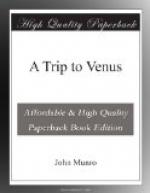The territory of Womla may be divided into three zones, namely, a central plain under cultivation, a belt of undulating hills, kept as a park or pleasaunce, and a magnificent, nay, a sublime wilderness, next to the crater wall.
The natural wealth of the country is very great. Some of its productions resemble and others are different from those of the earth. We saw gold, silver, copper, tin, and iron, as well as metals which were quite new to us. Some of these had a purple, blue, or green colour, and emitted a most agreeable fragrance. There are granites and porphyries, marbles and petrifactions of the most exquisite grain or tints. Precious stones like the diamond, ruby, sapphire, topaz, emerald, garnet, opal, turquoise, and others familiar or unfamiliar to us, fairly abound, and can be picked up on the shores of the lake. I presume that many of them have been formed on a large scale in chasms of the rock by the volcanic fumes of the crater.
What struck us most of all, however, was the prevalence of phosphorescent minerals which absorbed the sunlight by day, and glimmered feebly in the dusk. Professor Gazen seems to think that the presence of snow and clouds, together with these phosphorescent bodies, may help to account for the mysterious luminosity on the dark side of Venus.
The vegetation is wonderfully rich, varied, and luxuriant. As a rule, the foliage is thick and glossy; but while it is green to blackness in some of the trees, it is parti-coloured or iridescent in others. Many of the flowers, too, are iridescent, or change their hues from hour to hour. The beauty and profusion of the flowers is beyond conception, and some of the loveliest grow on what I should take for palms, ferns, canes, and grasses. A distant forest or woodland rivals the splendid plumage of some tropical bird. We heard of “singing flowers,” including a water-lily which bursts open with a musical note, and of many plants which are sensitive to heat as well as touch, and if Gazen be correct, to electricity and magnetism. We saw one in a house which was said to require a change of scene from time to time else it would languish and die.




